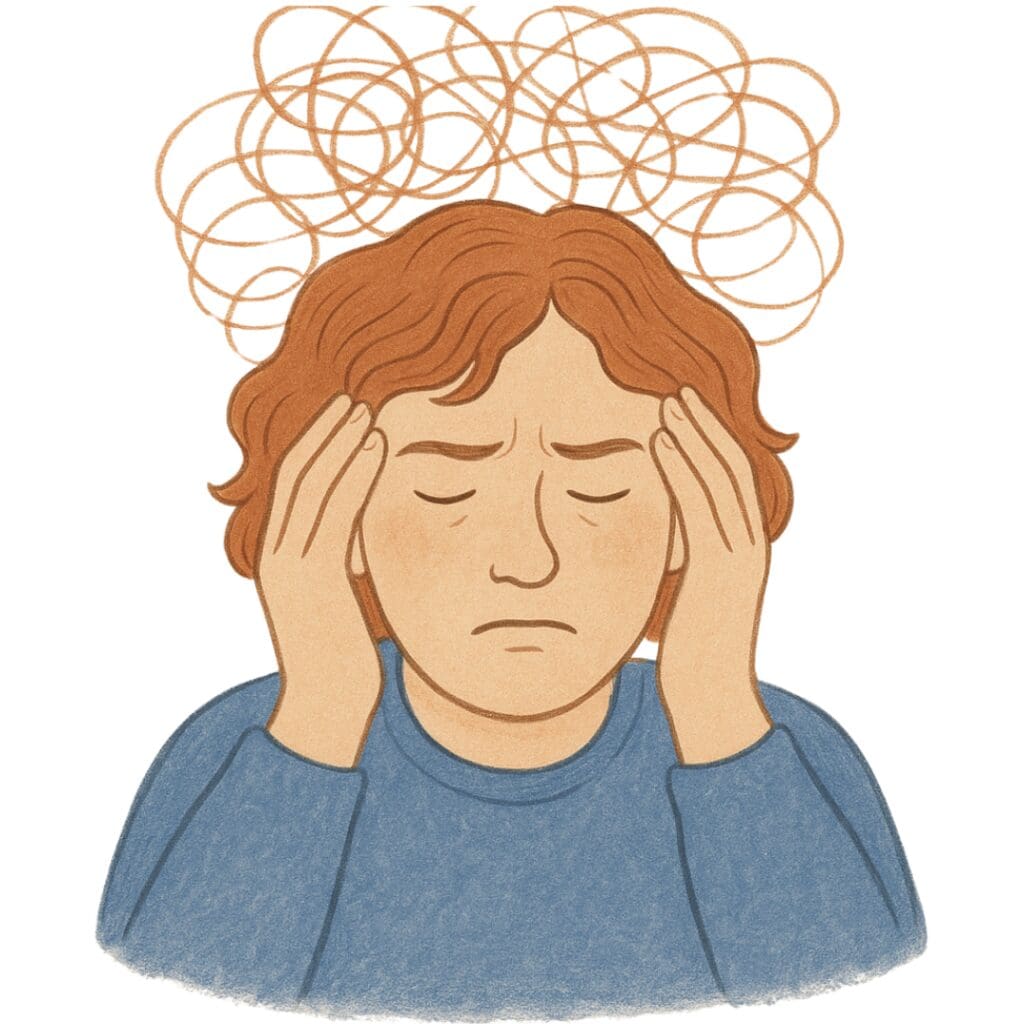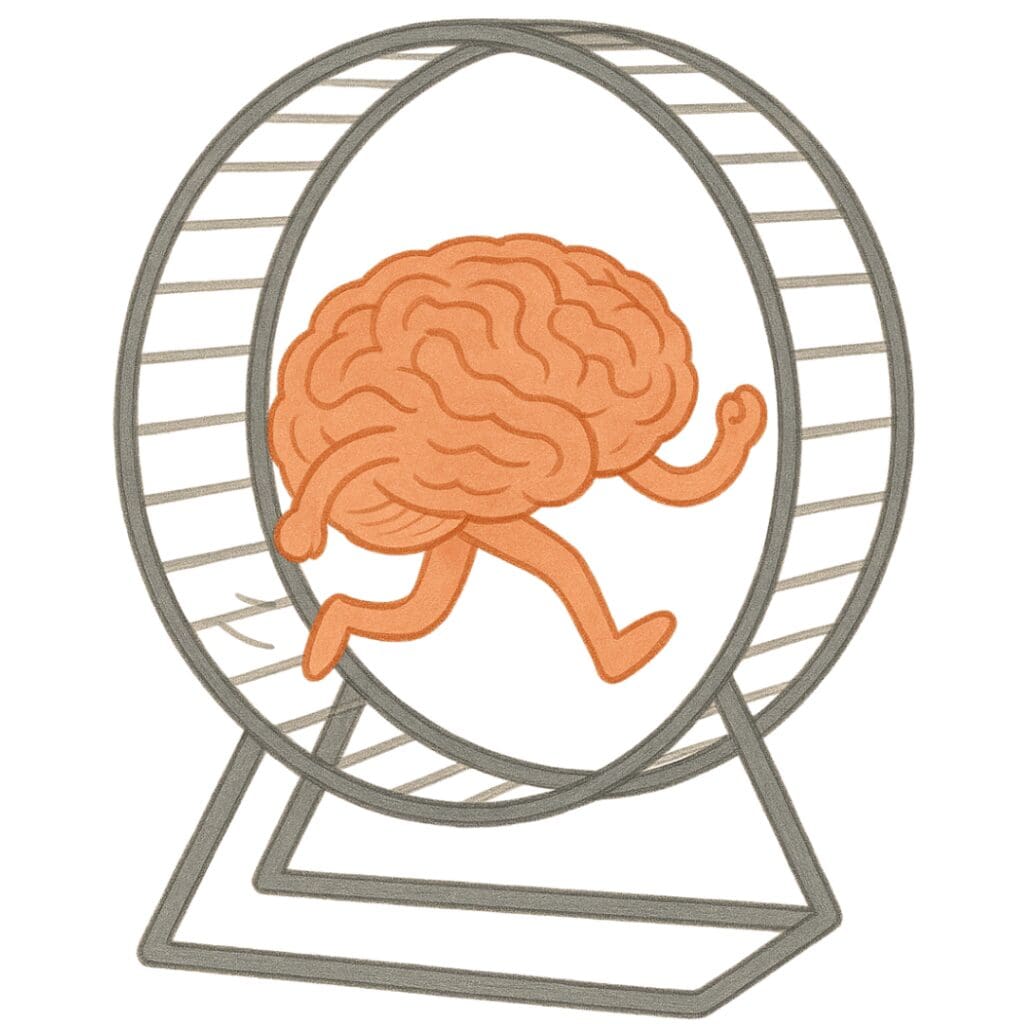How to Stop Overthinking
Does your mind ever feel like a hamster wheel, endlessly replaying conversations, forecasting worst-case scenarios, or dissecting problems until you’re more tangled than when you started? If so, you’re not alone. This exhausting mental loop, known as overthinking, is a common experience, often fueled by underlying stress and anxiety. And it doesn’t just drain your mental energy; it can trigger very real stress responses in your body.

The good news? Overthinking isn’t a permanent personality trait. It’s often a symptom of a dysregulated nervous system – a pattern that can be understood, interrupted, and transformed. This guide will explore what overthinking truly is, why your nervous system is the key, and practical, body-first strategies to break free.
*ps. If you’d rather tune in that read, click here to check out my podcast episode on this topic
What Exactly Is Overthinking?
Overthinking is an excessive, often circular, pattern of thought that doesn’t lead to resolution. It generally takes two main forms:
1. Rumination: Repeatedly focusing on past events, mistakes, or problems—replaying them in your mind and analyzing what went wrong or how things could have been different.
2. Catastrophizing: Your mind jumps to the worst-possible future outcomes. You excessively worry about what might happen, trying to plan for or control every eventuality, leading to heightened anxiety.
Both are rooted in your nervous system trying to prepare or protect you. But unlike productive problem-solving, which is usually calm and purposeful, overthinking feels urgent, repetitive, and leaves you feeling stuck and exhausted.
The Real Culprit: Your Nervous System is Sounding the Alarm
Here’s the crucial insight many miss: overthinking isn’t just a “thinking” problem; it’s a nervous system problem.
Your nervous system can’t always tell the difference between a real, present danger and an imagined one. When you ruminate on a past regret or catastrophize about a future event, your body can react as if the threat is happening right now. This often triggers your sympathetic nervous system – your “fight-or-flight” mode – releasing stress hormones like cortisol and adrenaline. Your heart might race, breathing becomes shallow, and muscles tense.

Essentially, your anxious thoughts activate a stress response, and this physiological alarm then fuels more anxious thinking. It’s a cycle:
- Your nervous system gets activated (feels unsafe or alarmed).
- Your brain tries to make sense of this internal alarm by scanning for threats (real or imagined).
- This search generates more anxious thoughts and “what if” scenarios.
- These thoughts further convince your nervous system that there’s danger, keeping the cycle going.
As it’s often said, your state determines your story. If your body is sending “I’m not safe” signals, your brain will work overtime to write a story explaining why, even if your external environment is perfectly safe. I often tell my clients, “You can’t solve an overthinking problem with more thinking.” You need to address the underlying state of your nervous system.
Why Do We Overthink?
Several factors can contribute to a tendency toward overthinking:
1. A Dysregulated Nervous System
When you’re in an activated (yellow zone) or shut down (red zone) state, your logical brain has reduced access to the prefrontal cortex—the part of your brain responsible for rational thinking and decision-making. This makes breaking the overthinking cycle particularly difficult.
As I explain in my podcast, “When you’re in these dysregulated states of fight, flight, freeze, or shutdown, you literally do not have access to as much of this logical part of your brain, making it harder and harder to reverse that overthinking spiral with brain power alone.”
2. Learned Response from Past Experiences
Overthinking is often a learned coping mechanism developed in response to unpredictable or overwhelming experiences, particularly during childhood. If you grew up in an environment where you needed to be hypervigilant to stay safe, your nervous system learned to constantly scan for threats and prepare for every possible scenario.
3. Habitual Patterns
Over time, this hypervigilance can become a deeply ingrained habit. Your brain becomes conditioned to jump to worst-case scenarios or analyze situations extensively because it believes this will keep you safe.
4. Unmet Needs
Overthinking can also be triggered by underlying physiological needs (like lack of sleep or poor nutrition) or emotional needs that aren’t being addressed. Your body’s stress signals get misinterpreted as anxiety about external threats rather than internal needs.
The Two Tones of “What If”
A key insight that helps many of our clients is understanding the difference between harmful overthinking and productive problem-solving. I call this “the two tones of what if.”
When you’re in a dysregulated state and asking “what if” questions, they often sound anxious and spiraling: “What if I mess up this presentation? What if everyone thinks I’m incompetent? What if I lose my job?”

But when you’re in a regulated state, those same questions can be approached with curiosity and resourcefulness: “What if I feel nervous during my presentation? What could I do to ground myself? What resources could I prepare in advance?”
The difference isn’t necessarily in the questions themselves, but in the “tone” or nervous system state from which you’re asking them.
How to Stop Overthinking: The 4 S’s Approach
Breaking free from overthinking requires addressing both your nervous system and your thought patterns. Here’s a 4-S framework:
1. Stop: Catch the Spiral
The first step is awareness. Recognize when you’re caught in an overthinking loop. Don’t judge it, just notice it. This creates a crucial pause.
- Try the “Maybe” Technique: When you catch a catastrophic thought, gently insert “maybe.”
- “I’m going to fail this exam” becomes “Maybe I’ll fail this exam, maybe I won’t.”
- “This is going to be a disaster” becomes “Maybe this will be a disaster, maybe it won’t.”
This simple word introduces flexibility, interrupting the certainty of anxious predictions without invalidating your feelings.
2. Settle: Regulate Your Nervous System
Once you’ve paused the overthinking spiral, the next step is to regulate your nervous system. Remember, you can’t effectively problem-solve from a state of dysregulation. Match your strategy to your energy:
- For High Activation (anxious, panicky, restless):
- Move the Energy: Walk briskly, shake out your limbs, jump, dance. Give the mobilized energy an outlet.
- Temperature Change: Splash cold water on your face, hold an ice cube, or take a warm shower.
- Intense Sensory Input: Bite into a lemon, smell strong essential oils (peppermint), listen to loud, rhythmic music.
- For Moderate Activation (uneasy, worried):
- Rhythmic Movement: Gentle swaying, rocking, self-hug.
- Breathing Practices: Focus on extending your exhale (e.g., inhale for 4, exhale for 6). Try a physiological sigh (two quick inhales through the nose, followed by a long, slow exhale through the mouth).
- Orienting: Slowly look around your environment, noticing colors, shapes, and objects. Name them silently. This helps your brain register present-moment safety.
- For Mild Activation (slightly unsettled):
- Gentle Breathing: Simply bring awareness to your breath without trying to change it.
- Body Awareness/Grounding: Feel your feet on the floor, your body in the chair. Notice physical sensations.
Oftentimes the key is to match the intensity of your regulation strategy to the intensity of your activation. Meet your nervous system where it is first, then gradually guide it toward regulation.
3. Solve: Address the Issue (From a Calmer Place)
Once your nervous system has settled, you can return to the problem with more clarity, curiosity, creativity, and perspective.
Practices:
- Write It Down: Externalize your concerns onto paper.
- Identify Control: What’s within your control? What isn’t? Focus your energy on the former.
- Break It Down: If a problem feels overwhelming, divide it into smaller, manageable steps.
- Shift Perspective: What would you tell a friend in this situation?
- Time Limit: Set a specific, short time (e.g., 15 minutes) for focused problem-solving, then move on.
4. Seek Support
Sometimes, overthinking patterns are deeply ingrained and difficult to interrupt on your own. Don’t hesitate to reach out for support when needed.
Types of Support:
- Professional help from a trauma-trained therapist or coach
- Trusted friends or family members who can offer perspective
- Community spaces (like our Regulated Living membership) where you can learn alongside others
Daily Practices to Prevent Overthinking
While the 4 S’s approach helps interrupt overthinking in the moment or retroactively, these daily practices can reduce the frequency and intensity of overthinking:
- Regular Nervous System Regulation: Incorporate short regulation practices (breathing, movement, mindfulness) into your day, even when you feel calm. This builds resilience.
- Mindful Media Consumption: Notice how news, social media, or certain shows affect your anxiety levels. Create boundaries around content that tends to trigger overthinking.
- Scheduled “Worry Time”: Consider designating a specific amount of time each day to actively think about your worries. If anxious thoughts arise outside this time, gently tell yourself you’ll address them during your scheduled slot.
- Practice Self-Compassion: Overthinking often comes with harsh self-criticism. Treat yourself with the same kindness and understanding you’d offer a friend. Remember, overthinking is often a learned attempt to stay safe.
A Final Note

You can’t outthink an overthinking problem. But you can shift the internal state that’s driving the spiral.
At Regulated Living, we teach clients how to:
- Recognize overthinking as a nervous system cue
- Regulate before responding
- Rewire their patterns with curiosity, not control
Overthinking isn’t a flaw. It’s a flag from your nervous system indicating it feels overwhelmed or unsafe. And the more you learn to work with your body, the more clarity and calm become available. Be patient and compassionate with yourself. Each time you notice overthinking and consciously choose to Stop, Settle, and then Solve, you’re rewiring your brain for greater peace and resilience.
Want more personalized support with overthinking? Explore our Regulated Living Membership; apply for Restore, our 1:1 anxiety & depression coaching; or join my monthly Release Class for more guided practices and individualized strategies tailored to your unique nervous system patterns.
Disclaimer: This article is for informational purposes only and is not a substitute for professional medical advice, diagnosis, or treatment. Always seek the advice of your physician or qualified mental health provider with any questions you may have regarding a medical condition.
Leave a Reply Cancel reply
A mental health newsletter that feels like a deep breath: simple, grounding, and here to remind you that healing is possible.
The Weekly Rewire
Navigate
Regulated Living provides neuroscience-backed mental health coaching to help you regulate your nervous system and reclaim your life from anxiety and depression.
Heal
Learn
Paragraph